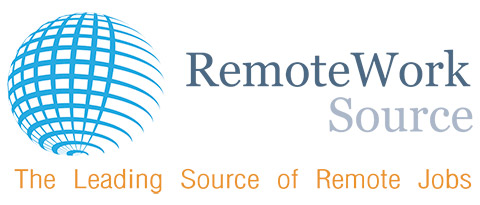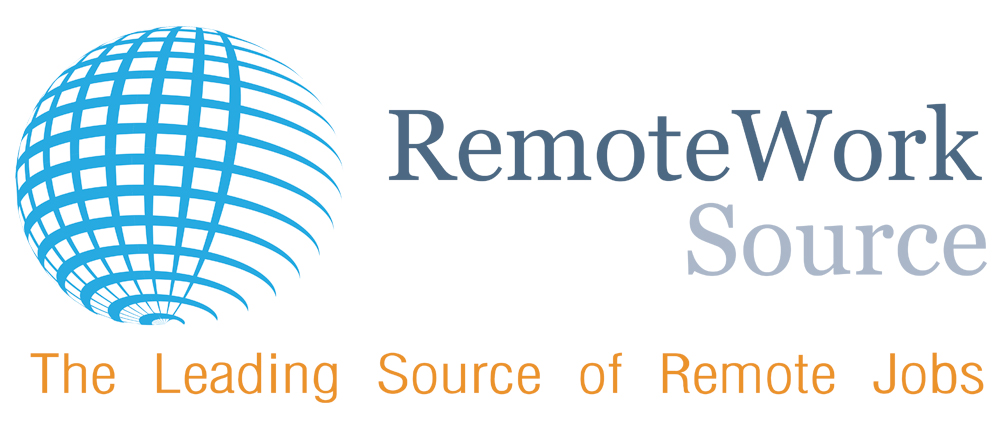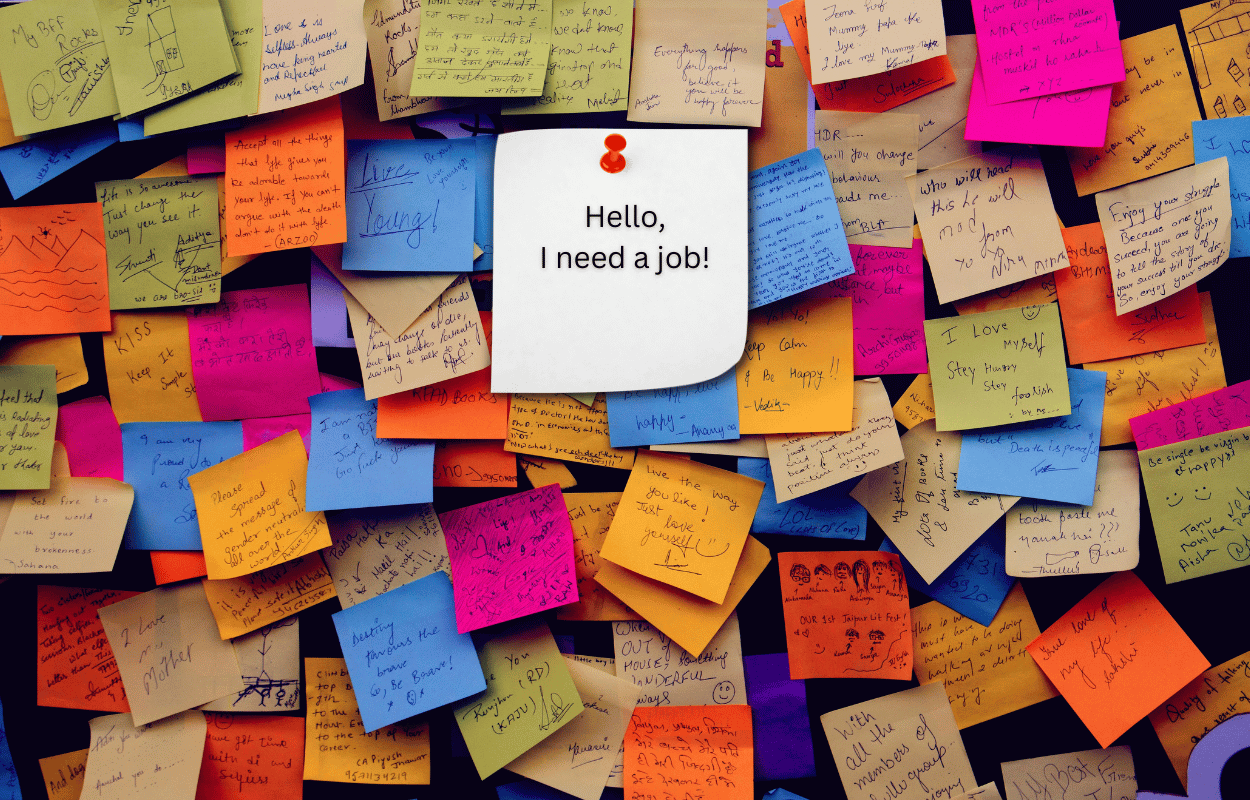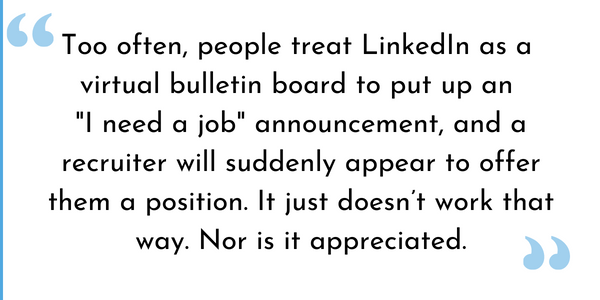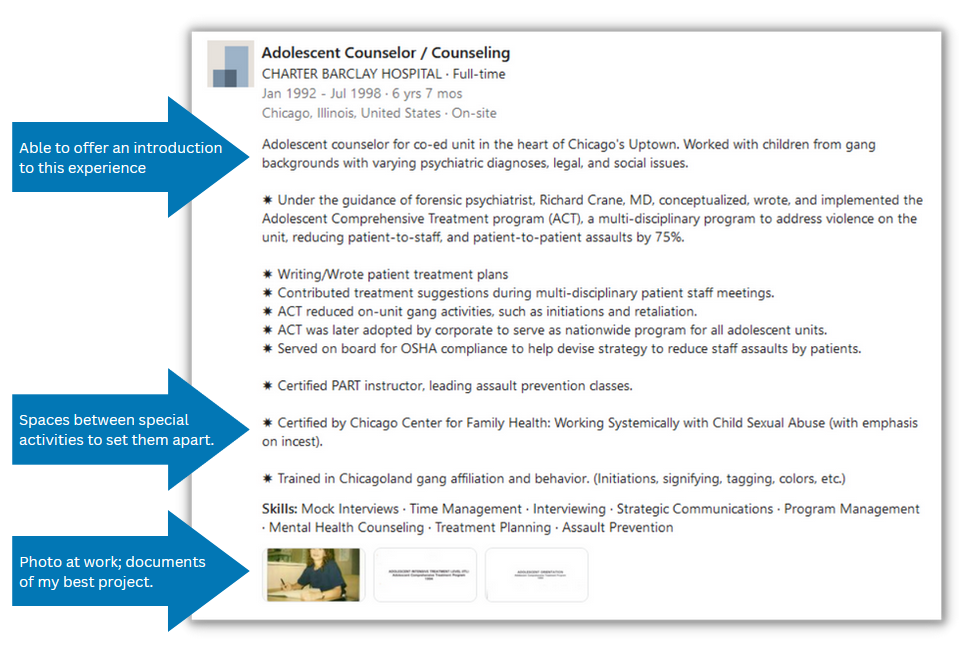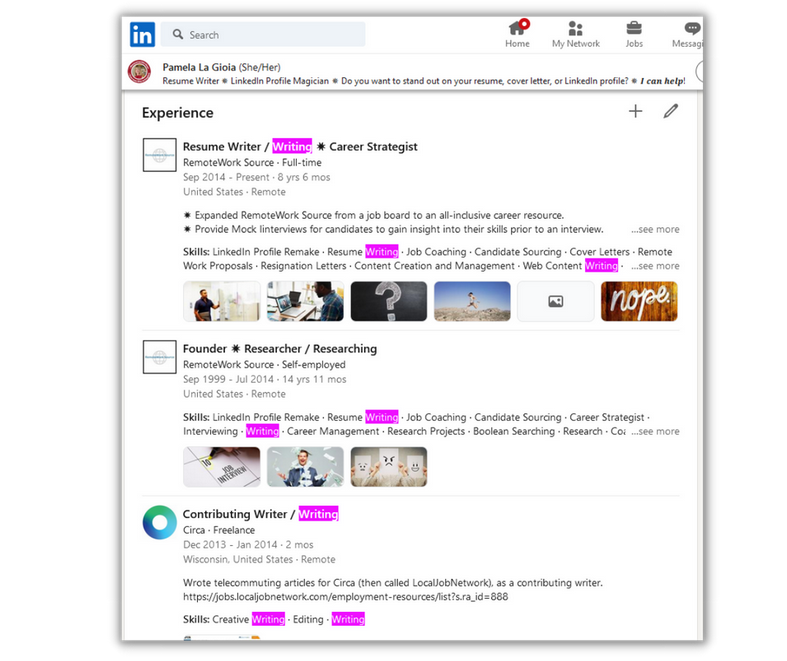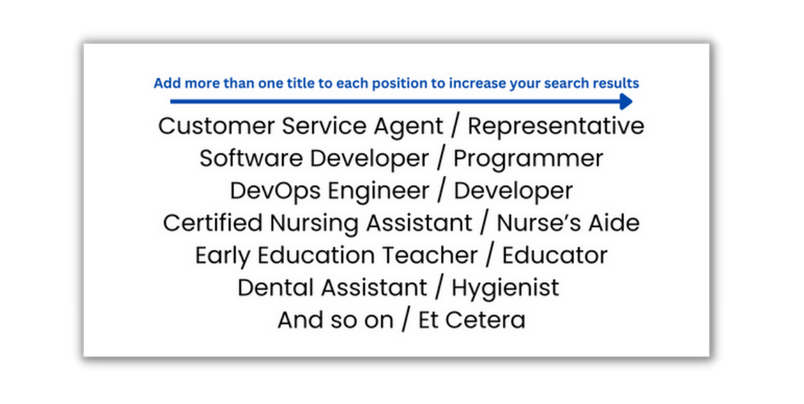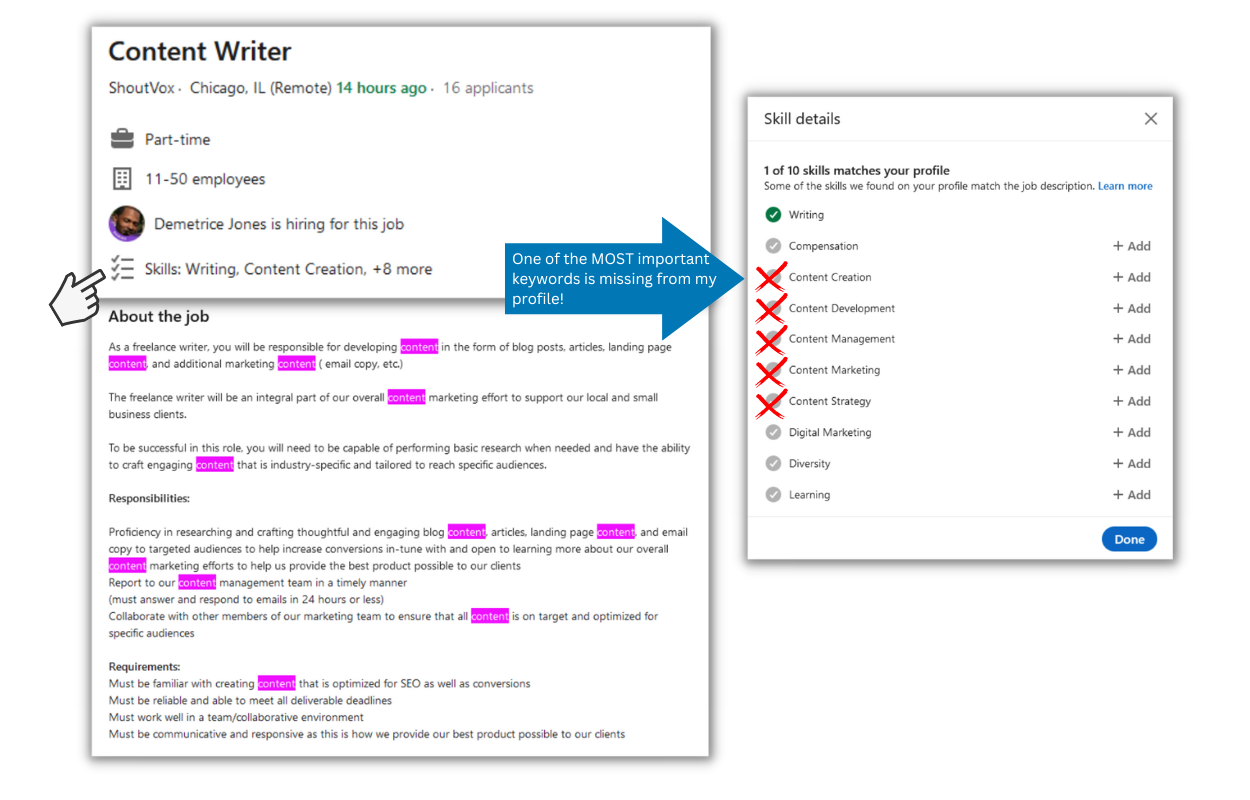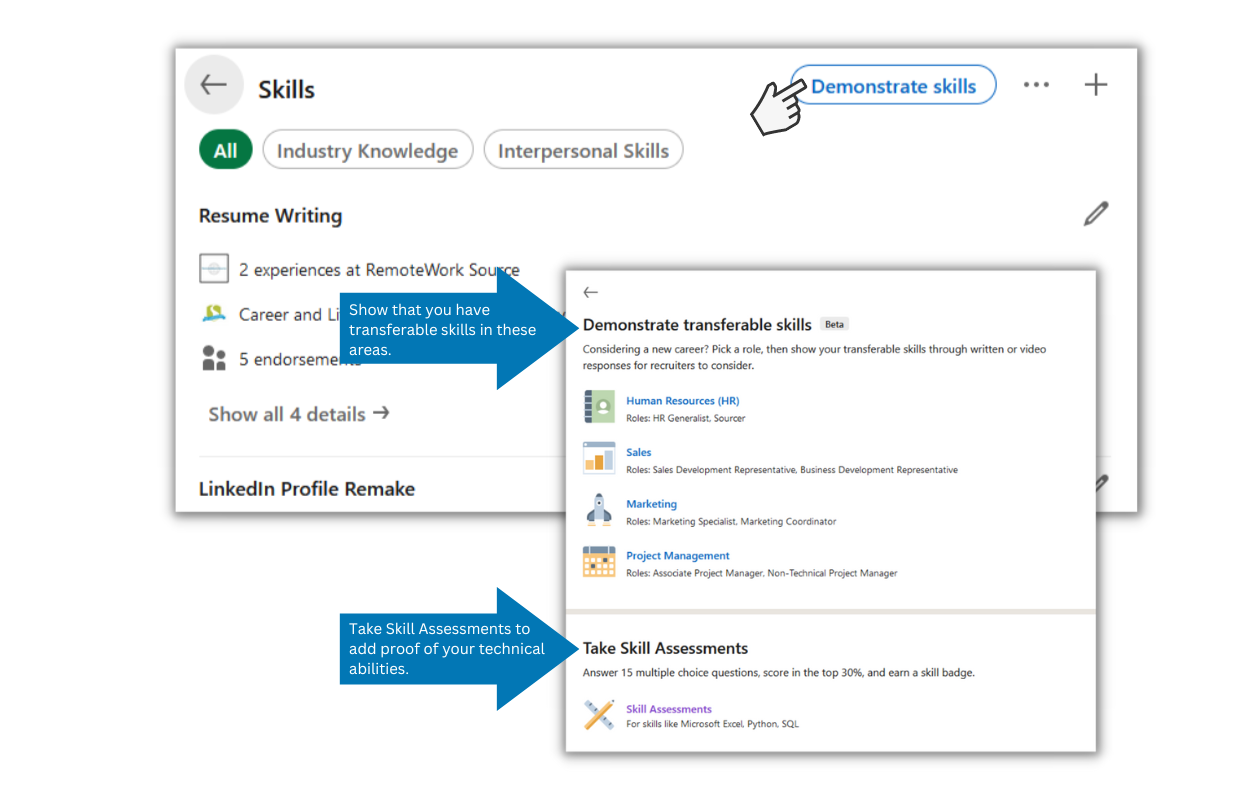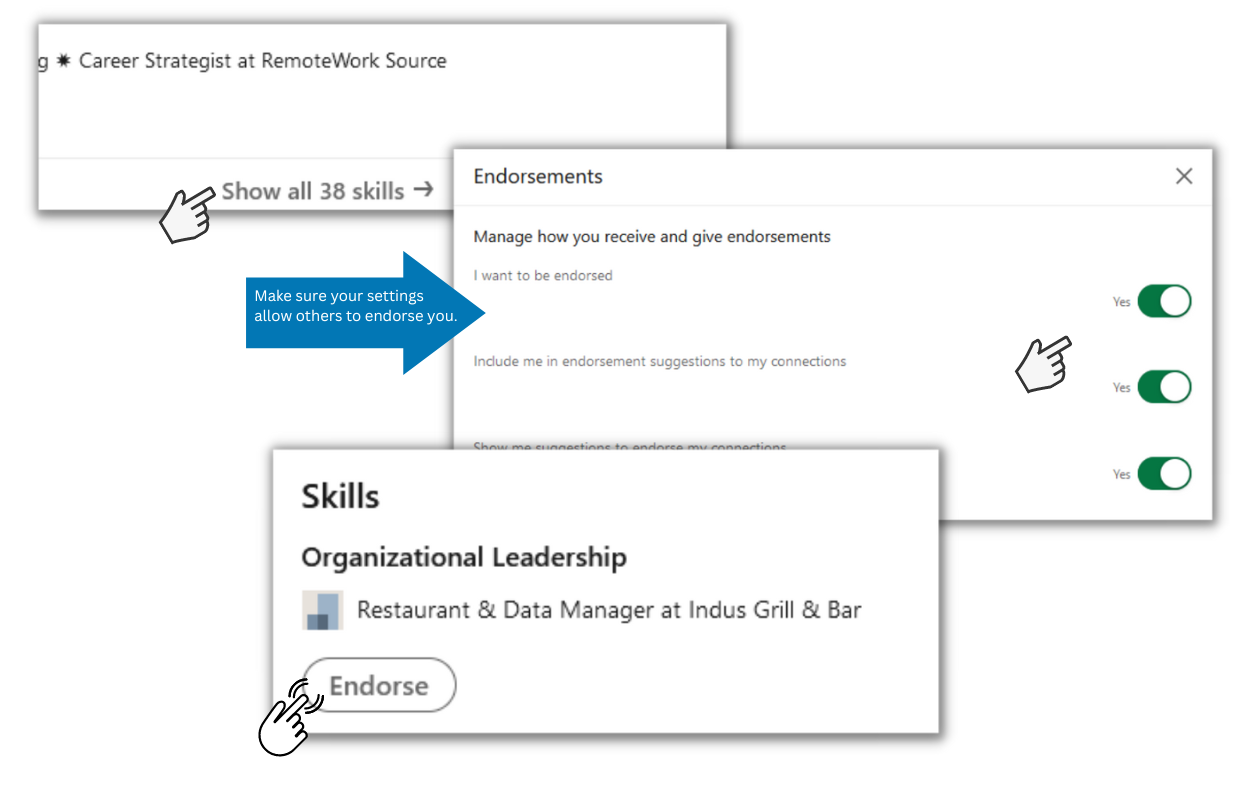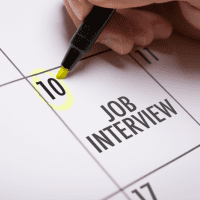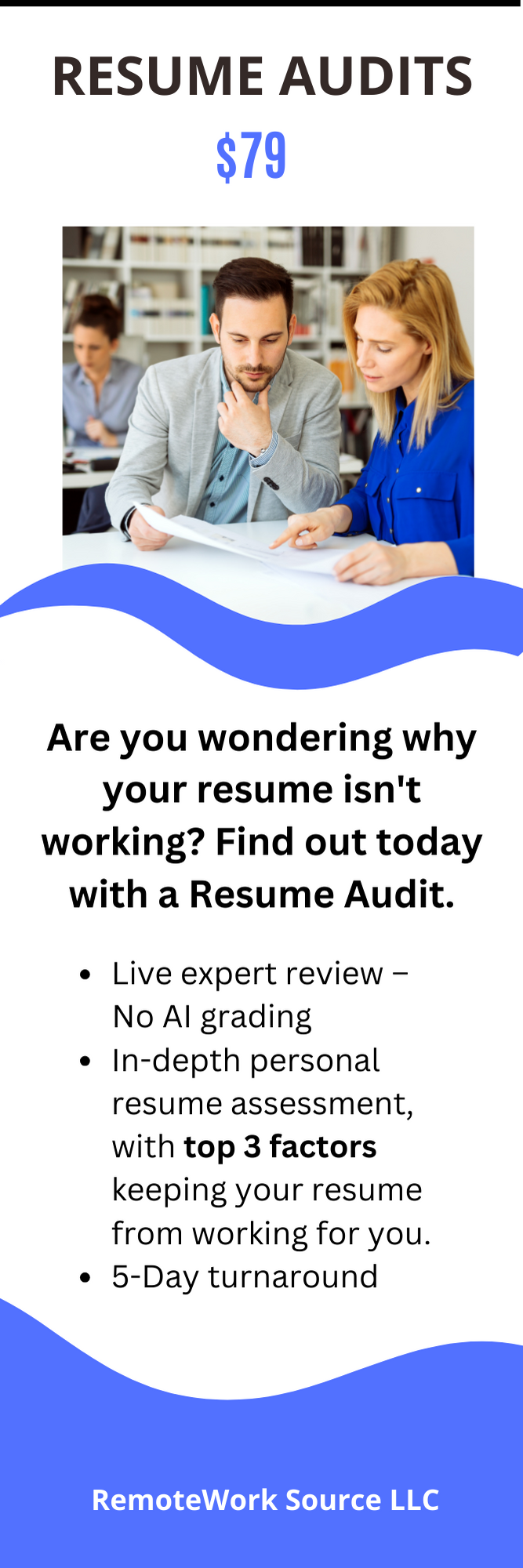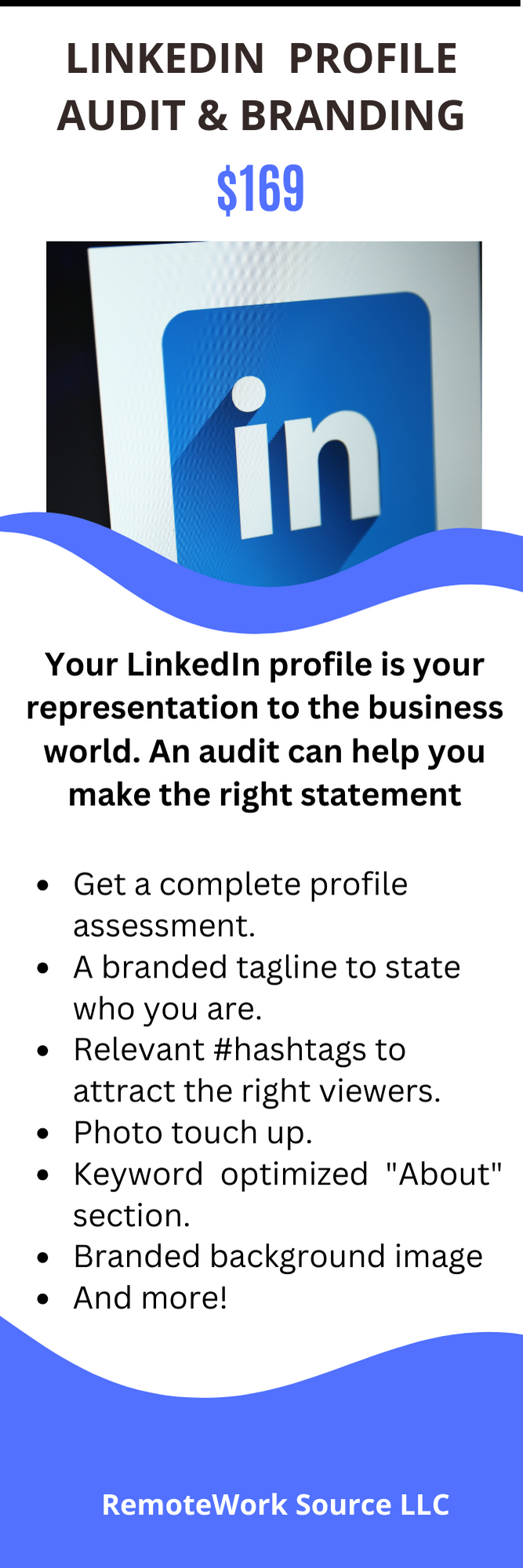The Job Seeker’s Complete Guide to Building an Outstanding LinkedIn Profile (Part II)
In Part I of creating an exceptional job seeker LinkedIn profile, we talked about the purpose of having a LinkedIn profile and what makes a profile engaging. We talked about the importance of your photo, and also how crucial having the right tagline is to attract recruiters. Then we covered the About section and offered suggestions to make it engaging as well as keyword optimized. In Part II, we’re going to step it up a notch.
In Part II, you will learn about:
Your Activity section, and the importance of engaging
Your Experience section, the similarities and differences from a resume
Your Education section, and how to make it more appealing
Your Skills section, how to feature the right skills for you
Your Recommendations section, focusing on quality over quantity
Let’s jump right into the second part of our LinkedIn profile lesson and talk about the other important sections. We’ll also offer insight into how recruiters use the components of your LinkedIn profile to help them in their candidate searches. After you finish, please download a workbook/checklist to help walk you through this, step by step.
LinkedIn Activity section
Are you alive on LinkedIn? Do you engage others by giving friendly feedback on their posts? Being active on LinkedIn is crucial for a healthy LinkedIn profile. For one, it helps grow your network with quality connections, people you’re interested in and who are interested in you, because you share common interests.
Second, engaging with your network is visible in the Activity section of your LinkedIn profile and the text content is searchable! Be strategic about your comments, as long as they are authentic and relevant. For example, if you want to increase your chances of being included in searches for the keyword “engineer,” follow fellow engineers and make comments on their posts using the word “engineer.” Or share posts that include the word “engineer.”
Third, your activity influences the content you see on LinkedIn. The platform’s algorithms try to show content similar to what you “like” or comment on, since LinkedIn assumes what you respond to is what you’re interested in. Want to see more posts related to engineering jobs, companies, or topics? Start “liking” and commenting on posts you see with engineering as the focus.
But most important, understand this: “Posting is not a one-and-done thing. It’s a career management strategy and a regular activity that you do once or twice a week, every week,” says Robin Ryan, on Forbes. “So, schedule the time to do this on your calendar. It shouldn’t take you more than five minutes. Give this some thought, then list some topics you’d stop to read about.”
Too many people view LinkedIn as a virtual bulletin board, where they can pop by to put up an “I need a job” notice, and a recruiter or connection will appear out of nowhere to offer them a position, or connect them to a job lead. It doesn’t work this way. Inside the LinkedIn platform are untold communities of people who have built relationships by diligently sharing and adding value to the lives of others. They do not appreciate the bulletin board approach.
LinkedIn Experience section
This section seems so obvious. It looks like a place to list your earlier work experience in reverse-chronological order, like a resume. So, why not just copy and paste the content from your resume into the Experience section and call it a day? Because your LinkedIn Experience section has a much broader audience.
When you have an interesting story, you rarely tell it the same way to everyone. Most likely, you vary it depending on your audience. Of course, the facts of the story stay consistent. But depending on your audience, you give all the details or you leave out parts to make it more concise or relevant. This is like the way you share your career story on LinkedIn versus on a resume.
Your resume document needs to be concise and tailored to each specific job and company you’re targeting. You should leave out irrelevant details, focusing on your qualifications relevant to each specific position.
Your LinkedIn experience section is more rounded than a resume. It allows you to go into detail about each job you had. Readers do not read your LinkedIn experience section with the same time constraints as a resume, allowing you to make it interesting to readers. You can also include attachments to showcase projects or documents related to your accomplishments from each position.
Not that your LinkedIn Experience section should branch in every direction. You should still gear it toward the industry and even the job category in which you wish to work. In Part I, we talked about using keywords in your profile Tagline and About sections to attract recruiters using keywords to find candidates.
You should also use keywords that would be used in a candidate search. But, include more than cut-and-dry bullet points to detail your work experience. Let’s read an example of the difference in a statement on a resume and in a LinkedIn profile.
Know your audience
Let’s say you are interested in a recruiting position. You have several years’ recruiting experience. In your last recruiting position, you were with a small company, so you wore several hats. You assisted the marketing team with various tasks; and you also took a project unrelated to recruiting because the person running the project left.
These other “hats” gave you new skills and accomplishments that are valuable. In fact, the project you took over enabled your company to receive government contracts, increasing revenue by $1 million!
Now you’re on the market, seeking a recruiting position. Remember, a resume highlights selective and specific experiences tailored to each target job. Mentioning your experience in marketing and project management may not apply to your target job, so despite how proud you are of those accomplishments, it might be confusing if you put them on your resume.
On LinkedIn, however, you can showcase those other skills and accomplishments. While they still may not apply to a recruiting position, the reader from your LinkedIn audience will note them and conclude that you are a team player, willing to extend yourself to others to get things done, and a valuable asset to a company.
Another advantage of your LinkedIn Experience section is that you can make advancements and promotions easy to see by positioning them apart from your job experiences. You don’t have to bury them in bullet points, or send them to the bottom of your resume. Following each set of bullets, double-space and point out those promotions!
Finally, while a resume can allow you to highlight your top skills in a Core Competencies section, LinkedIn lets you point them out after each job you mentioned in your Experience section. This helps drive them home.
Resume and Experience section similarities
Despite the contrast between a resume and a LinkedIn Experience section, there are areas where they should be consistent, beyond actual job titles and dates.
Tailor your experiences to a target position in the following ways:
- Use common job titles. If a previous job gave you a title like “Client Happiness Engineer,” a recruiter searching for a “Customer Service Agent,” or even a “Customer Success Associate” will not likely find you. Use titles that are most common to your target job, and most searched.
- Tailor past experience. Even though you can go into more detail in your earlier experiences, try to tailor them to match your target position. Put the most relevant and identical bullet points higher in your experience descriptions.
- Show career progression. Whether on a resume or your LinkedIn profile, demonstrating career progression is important. Promotions within a position are great. But so is showing upward mobility from one position to the next. Try to show this upward mobility in your Experience section.
- Watch the language. Avoid using excessive adjectives that make your experience sound like fluff. Steer clear of buzzwords, jargon, and cliches that recruiters find so annoying.
Here’s a tip to help you see if your LinkedIn profile is picking up keywords recruiters would use to fill positions you want to target. It’s a trick recruiters use to help them save time when they have to view keywords in someone’s profile quickly. Hold down the Ctrl and F keys and a search bar will appear at the bottom of your browser.
Choose a word that recruiters are likely to use as a keyword in their search. I used “writer” as my example. Once you enter a keyword, any matches found on your profile will become highlighted, from any place—your LinkedIn skills, your tagline, and even the tagline of people who have given you LinkedIn recommendations. This is a great tool to help you see if your profile needs more relevant keywords.
By the way, notice I’ve included two variations of “writer.” In case someone searches for “resume writing” instead of “resume writer,” I’ve included the word “writing” with my titles. I suggest trying this only if it doesn’t look odd. You’ll be surprised to see how many job titles can use this trick.
Cover your bases. Successful job hunting requires strategy, and even the smallest detail can make a difference.
LinkedIn Education section
Like your Experience section, your LinkedIn Education section allows for a bit more elaboration. You can and should include university activities and societies, such as special clubs or associations. Adding a small list of topics that might apply to your target job is a good way to make good keywords. You can include a few comments about any special projects you completed. And you can mention your internship (s).
[Note: Adding your internship in your Experience section may or may not work, depending on where you are in your career and how relevant it is to where you are going. But even at later stages in your career, if you’ve had an accomplished internship there’s no harm in mentioning it in your Education section.]
LinkedIn offers a place for you to add key skills picked up from each school you attended. So take advantage of this section to help you stand out, as well as be easier to find during a recruiter’s search.
LinkedIn Skills section
The Skills section on your LinkedIn profile is not just filler content. It’s important, so use it! Recruiters use the Skills section as a recruiting tool, helping them to find talent.
“More employers are leaving behind college degree requirements and embracing a skills-based hiring approach that emphasizes strong work backgrounds, certifications, assessments, and endorsements. And soft skills are becoming a key focus of hiring managers, even over hard skills,” writes Lucas Mearian on Computerworld.com.
Use strategy when listing your skills
LinkedIn will automatically place the skills you listed after each job in your Experience section in the Skills section. And you can add as many as you want. However, it’s best to be strategic about the skills you add.
To help you know the best skills to include in your Skills section, examine the required skills from one or two jobs you are targeting. If you’re targeting a job posted on LinkedIn, this process is simple. Let’s see how this would work with my profile, using this job ad from LinkedIn. Using this “Content Writer” job ad, I highlighted “content” with Ctrl-F. This is clearly an important qualification, or required skill. Then, I clicked the part on the page that will open up a list of all required skills. From that, LinkedIn shows me what skills I do or don’t have on my profile that match the required skills for the job. My results are not good.
As you can see, not many of my listed LinkedIn skills match up to my target job example, especially “content,” which it a top keyword. If I were targeting this position, this would be a problem. Seeing what I lack helps me know what I need to include in my LinkedIn skills. (Which I have added.) And, it tells me what skills are most important. From this list, I can choose to remove irrelevant skills from my Skills section. I can also rearrange them, making sure they feature the top skills required first.
Another excellent feature to take advantage of in the LinkedIn Skills section is the “Demonstrate” skills option. Because this is still a new feature, the options are few, but if they match your skill set and you want to prove that you have them, take the online tests and you will have verified skills to showcase on your profile.
Skills Endorsements
One other way to boost your Skills section is to receive skill endorsements from your LinkedIn 1st degree network. They can visit your page, and click on a skill to endorse one or more of them. To allow your network to endorse you, make sure your Endorsement settings are open. To encourage people to endorse you, visit their page and endorse them first.
LinkedIn Recommendations section
Do you visit someone’s profile and envy their well-stocked Recommendations section? I assure you, those LinkedIn recommendations took work to get. It’s unfortunate, but unless you ask someone for a recommendation, they won’t bother. Life is just too busy.
However, LinkedIn recommendations are important. They offer the equivalent of “customer reviews” for shoppers, or “social proof.”
Don Goodman and Jenna Arcand, on WorkItDaily.com, write, “Recommendations on LinkedIn are like doing a pre-check of your references. Recruiters want to see that you have other professionals in the field or industry vouching for your experiences, skills, and capabilities.”
Getting recommendations
Having LinkedIn recommendations from your supervisors, professors, clients, or employers are all great to have on your profile. But so are LinkedIn recommendations from former and current coworkers, people in other departments, and even junior staff under you. These recommendations give recruiters information that’s very important to them: what you’re like as a coworker.
“Reach out to managers and team members you’ve collaborated with to see if they’ll leave a recommendation on your profile. You could even remind them of a few highlights of your working relationship to help them write it. Better yet, offer to write one for them first before asking them to return the favor,” writes Jacob Johnson for CodeAcademy.com.
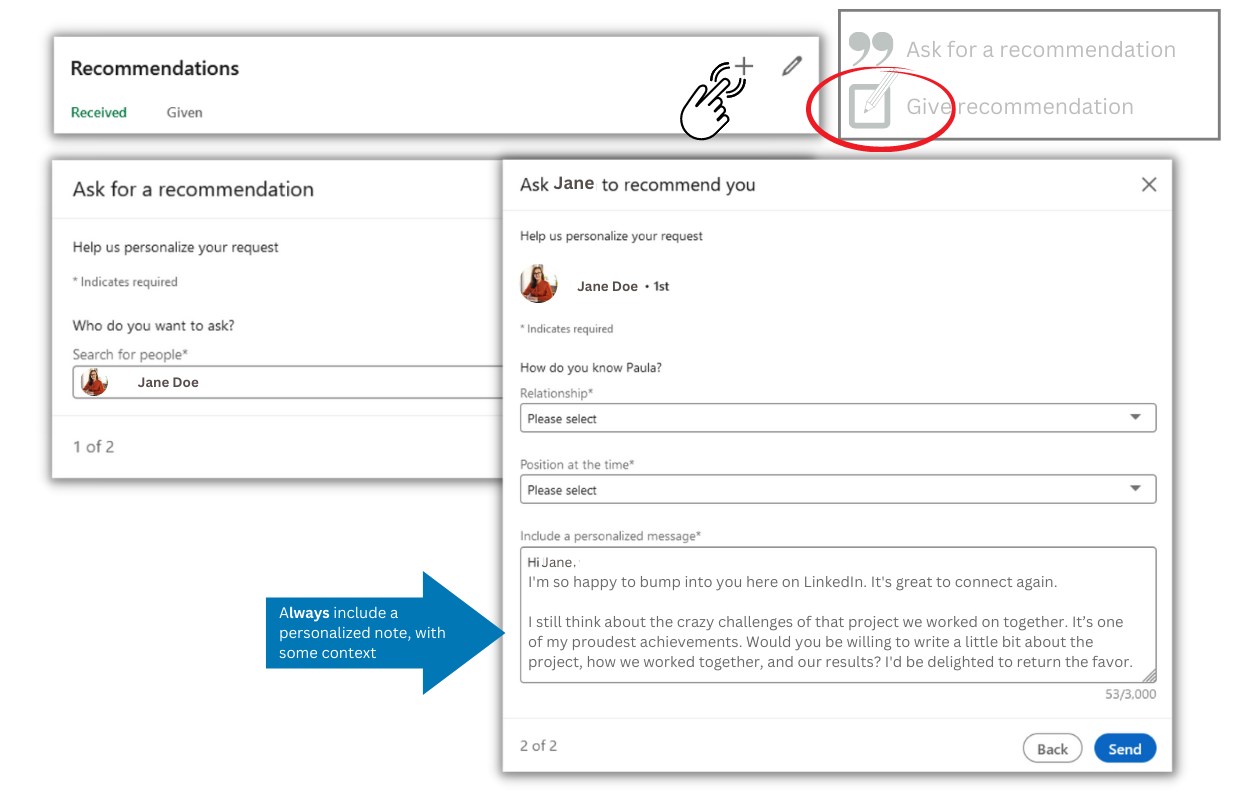
When asking for LinkedIn recommendations, be personal and give your request context. It’s all about relationships.
Not all LinkedIn recommendations are created equal. Quality over quantity is key. You can have twenty LinkedIn recommendations, and at first glance, it looks impressive. But after reading them, if they all offer the same, generic commentary: “John Doe was a great person to work with. An asset to the team,” they become meaningless.
So target those LinkedIn recommendations as carefully as you would your job references. Seek people who meet the following criteria:
- Have good online reputations
- Have had actual professional experiences with you
- Write well
- Can say something substantive
- You would reciprocate
- Can offer something different from others
Tips for sending them a LinkedIn recommendation request:
- Timing: Right after completing a successful project together. Or, after a friendly interaction with them somewhere.
- Reciprocate: Write them a recommendation first, or offer to write them one.
- Make it personal: Don’t copy and paste your way down your connection list. Individualize each note by mentioning something about them, about the work you did together, or about something you appreciate about them.
- Show your presence by liking and commenting on their posts.
Wrap up
In Part I of this LinkedIn series, you learned how to begin to build an exceptional job seeker profile. You learned how to write a powerful tagline to help recruiters find you. And you’ve learned the importance of having a keyword optimized profile that also aids in a recruiter’s candidate search.
Are you ready to give this a go? To help you even further to build a winning profile on your own, grab the below workbook/checklist download. By combining everything from Part I and Part II of this actionable LinkedIn series, you will be able to take an organized approach to creating the profile that works for you.
Category: Expert Advice, Featured, Free Download Included, Networking, Resumes, Social Media
